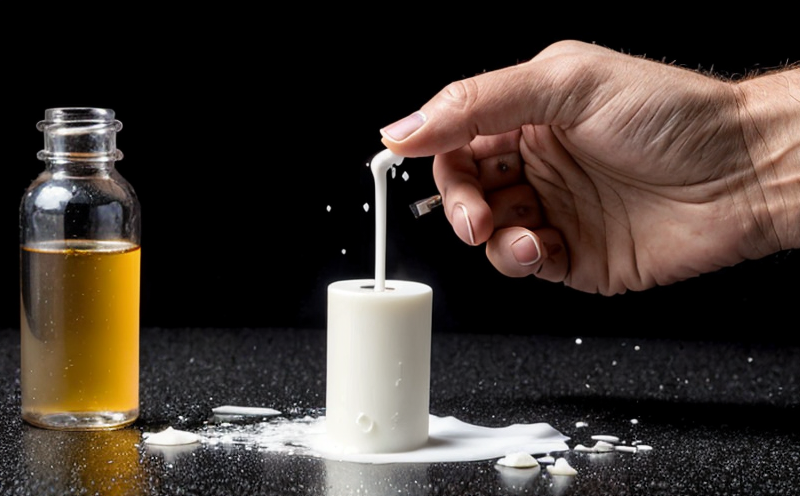USP Dry Powder for Reconstitution Dissolution Testing
The USP Dry Powder for Reconstitution Dissolution Test is a critical procedure used in pharmaceutical development and quality assurance. This method ensures that the drug product dissolves properly when reconstituted with water or another solvent, which is crucial for the efficacy of many solid dosage forms such as tablets, capsules, and powders.
The test follows specific guidelines outlined in the United States Pharmacopeia (USP) to assess the dissolution rate and degree of drug product dispersion. Dissolution testing measures how quickly and completely a pharmaceutical formulation can be absorbed by the body, which is essential for ensuring that the medication works as intended.
During this process, a known amount of dry powder sample is placed into a dissolution vessel containing the appropriate solvent (usually water). The vessel is then agitated under controlled conditions to simulate in vivo dissolution. Over time, the drug is dissolved and measured at specific intervals using analytical techniques such as UV-Vis spectroscopy or HPLC.
The test results provide important data on the product's performance, helping manufacturers optimize formulations for faster dissolving times while maintaining therapeutic efficacy. This service supports regulatory compliance by ensuring that products meet stringent quality standards set forth by regulatory bodies like the FDA and EMA.
Understanding the dissolution profile of a drug is vital not only during development but also throughout the lifecycle of a product, from formulation to stability testing. Properly conducted dissolution tests help identify issues early in the process, allowing for necessary adjustments before production begins or batches are released into the market.
The USP method for dry powder reconstitution dissolution testing offers several advantages over other dissolution techniques:
- It provides a more accurate representation of what occurs during actual administration.
- Results can be compared directly with historical data, facilitating trend analysis and process improvements.
- The test is simple to perform and interpret, making it suitable for both research and quality control applications.
By adhering strictly to USP guidelines, laboratories ensure consistency across different batches of the same product. This consistency is crucial when scaling up production from development stages to full-scale manufacturing, where slight variations could significantly impact the effectiveness of the drug.
| Parameter | Description |
|---|---|
| Dissolution Medium | Water or another appropriate solvent as specified in the USP monograph. |
| Temperature | 37°C ±1°C, unless otherwise specified by the product's label. |
| Sample Size | Typically 500 mg of the test sample. |
| Rotation Speed | 100 rpm ±2 rpm for small baskets or stir bars. |
| PH | Adjusted to 7.4 ±0.2 using phosphate buffer if not specified otherwise. |
The importance of accurate dissolution testing cannot be overstated, as it directly impacts patient safety and treatment outcomes. Ensuring that the drug product dissolves correctly is a fundamental step in ensuring its effectiveness and consistency across all batches produced by a manufacturer.
For more information on how our laboratory can assist with USP dry powder for reconstitution dissolution testing, please contact us today. Our experienced team of professionals will guide you through every aspect of the process, from sample preparation to final analysis.
Benefits
The implementation of USP Dry Powder for Reconstitution Dissolution Testing brings numerous benefits to pharmaceutical companies and healthcare providers. It ensures that the drug product is safe, effective, and consistent across all batches produced by a manufacturer.
- Regulatory Compliance: Adhering strictly to USP guidelines helps ensure compliance with international regulatory standards like those set forth by the FDA and EMA.
- Patient Safety: By ensuring that the drug product dissolves properly, this service reduces the risk of adverse reactions due to incomplete dissolution.
- Quality Control: The test provides valuable data on product performance, helping manufacturers optimize formulations for faster dissolving times while maintaining therapeutic efficacy.
- Process Improvement: Results can be compared directly with historical data, facilitating trend analysis and process improvements.
- Consistency: Ensuring consistency across different batches of the same product is crucial when scaling up production from development stages to full-scale manufacturing. Slight variations could significantly impact the effectiveness of the drug.
In conclusion, USP Dry Powder for Reconstitution Dissolution Testing plays a vital role in ensuring that pharmaceutical products meet stringent quality standards and are safe and effective for patients.
Industry Applications
| Sector | Application |
|---|---|
| Pharmaceutical Manufacturing | Determining the dissolution profile of new drug products. |
| Quality Control | Evaluating the consistency of batch-to-batch variations in product quality. |
| New Drug Application (NDA) Review | Supporting regulatory submissions by providing dissolution data for novel formulations. |
| Product Life Cycle Management | Monitoring the performance of existing products throughout their lifecycle to ensure ongoing efficacy and safety. |
The USP Dry Powder for Reconstitution Dissolution Testing is widely used in various sectors of the pharmaceutical industry. By following these standardized methods, manufacturers can ensure that their products meet rigorous quality standards, thereby enhancing patient safety and satisfaction.
Use Cases and Application Examples
- New Drug Product Development: During early stages of drug development, dissolution testing helps identify optimal excipient combinations that enhance solubility and bioavailability.
- Formulation Optimization: By assessing how different formulations perform in terms of dissolution rates, researchers can refine their approaches to improve product performance.
- Batch-to-Batch Variations: Regular testing ensures that each batch produced meets the same high standards, reducing variability between batches and ensuring consistent quality.
- Stability Studies: Dissolution tests are conducted periodically during long-term storage studies to monitor changes in product stability over time.
The USP Dry Powder for Reconstitution Dissolution Testing is an essential tool in the pharmaceutical industry, providing critical insights into drug performance and helping ensure that products meet all necessary regulatory requirements.





